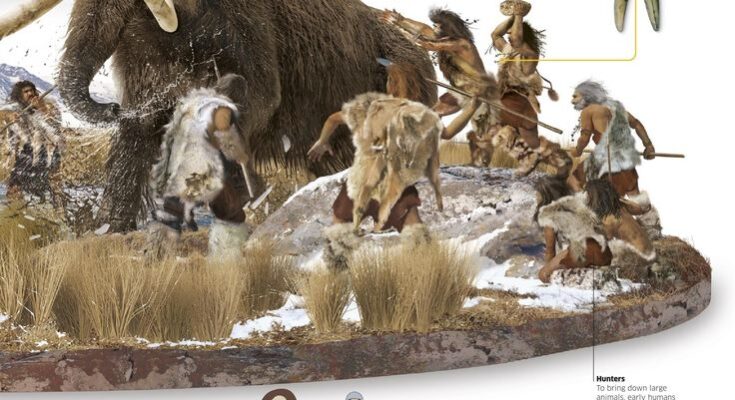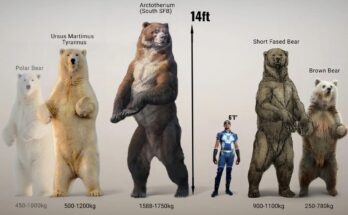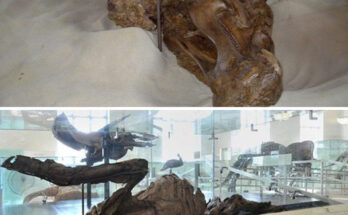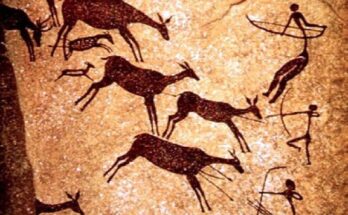Journey Back 73,000 Years: The Age of the Earliest Human Innovations
Step into the prehistoric world 73,000 years ago with this captivating exploration of early human life, as depicted in an educational chart from a historical publication. This detailed guide uncovers the remarkable innovations of our ancestors—clothing, music, jewelry, language, and hunting techniques—offering a vivid snapshot of their survival strategies and cultural development. Perfect for history buffs, educators, and curious minds, this post delves into the lives of early humans and their close relatives, the Neanderthals, based on archaeological discoveries from around the globe.

Clothing: Mastering the Elements
Early humans demonstrated ingenuity by crafting clothing to protect themselves from the cold. Made with bone needles, clothes were sewn with skill, as evidenced by a burial site in Sunghir, Russia, dating back 30,000 years. The chart highlights a skeleton adorned in elaborate attire, including a tunic and cap decorated with fox teeth, showcasing both functionality and artistry. This clothing, found intact, reflects a society that valued warmth and self-expression, adapting to harsh climates with materials like animal hides and furs.
Music: The Earliest Melodies
Music emerged as a cultural milestone, with 43,000-year-old flutes made from bird bones and ivory discovered in Germany in 2012. These artifacts, the earliest known musical instruments, suggest that early humans and Neanderthals used sound to communicate or entertain. The chart features an image of a bone flute, illustrating how these simple tools allowed for a range of vocal expressions, hinting at the beginnings of musical tradition and social bonding.
Jewelry: Symbols of Identity
Jewelry served as a form of personal adornment and possibly a marker of identity or status. The chart showcases a necklace crafted from shells, teeth, and ivory beads, with some pieces found far from their origins, indicating extensive trade or travel. Early humans and Neanderthals demonstrated skill in creating these items, using materials sourced from distant locations, as seen in the detailed illustration of a decorative ring, reflecting their resourcefulness and cultural exchange.
Language: The Power of Speech
The development of language marked a significant leap in human evolution, facilitated by the hyoid bone—a small structure in the throat. The chart includes an anatomical diagram of a human skull and hyoid bone, explaining how this bone’s position allowed for a wide range of vocal sounds. Unlike Neanderthals, who also had this capability, early humans likely used complex speech to coordinate activities and share knowledge, laying the foundation for advanced communication.
Hunting: Collaborative Survival
Hunting was a communal effort, with early humans using teamwork to bring down large animals. The chart depicts a dramatic scene of hunters wielding spears against mammoths, whose tusks and fur provided resources like ivory and clothing materials. Mammoths, covered with a thick layer of fat, were a vital resource, and their remains suggest humans defended themselves against these giants. This cooperative hunting, illustrated with dynamic figures, underscores the social structures that supported early human survival.
Neanderthals: Close Relatives
Neanderthals, close relatives of early humans, also contributed to this rich tapestry of innovation. The chart notes their use of painted caves and tools, with evidence of cultural overlap. A side image shows a Neanderthal figure, emphasizing their shared ingenuity with early humans, from crafting tools to creating art, as seen in cave paintings discovered alongside their remains.
The Context of Discovery
This 73,000-year timeline aligns with the age of the earliest known drawing, found in a cave, marking the beginning of human artistic expression. Archaeological sites, such as those in Russia and Germany, have unearthed these treasures, offering insights into a world where survival and creativity intertwined. The chart’s vibrant illustrations—ranging from skeletal remains to hunting scenes—bring this ancient era to life, supported by findings documented in historical records.
Why This Matters
These discoveries reveal the resilience and ingenuity of early humans and Neanderthals, shaping the foundation of modern civilization. From crafting clothing for warmth to developing language for connection, their innovations highlight a remarkable adaptability. This guide, enriched with visual details from the chart, invites you to explore the dawn of human culture and appreciate the legacy of our ancient ancestors.
Dive into this prehistoric journey and uncover the origins of humanity’s enduring spirit!
This detailed description is crafted for a website post, providing an in-depth look at each aspect of early human life while leveraging the visual elements from the chart to enhance the narrative and educational value.



